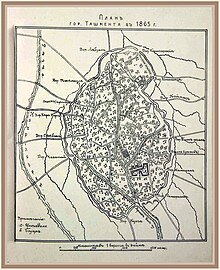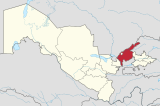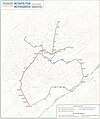The Tashkent Portal
Tashkent (/tæʃˈkɛnt/), or Toshkent in Uzbek, is the capital and largest city of Uzbekistan. It is the most populous city in Central Asia, with a population of more than 3 million people as of April 1st 2024. It is located in northeastern Uzbekistan, near the border with Kazakhstan.
Before the influence of Islam in the mid-8th century AD, Sogdian and Turkic culture was predominant. After Genghis Khan destroyed the city in 1219, it was rebuilt and profited from its location on the Silk Road. From the 18th to the 19th centuries, the city became an independent city-state, before being re-conquered by the Khanate of Kokand. In 1865, Tashkent fell to the Russian Empire; as a result, it became the capital of Russian Turkestan. In Soviet times, it witnessed major growth and demographic changes due to forced deportations from throughout the Soviet Union. Much of Tashkent was destroyed in the 1966 Tashkent earthquake, but it was soon rebuilt as a model Soviet city. It was the fourth-largest city in the Soviet Union at the time, after Moscow, Leningrad and Kyiv. (Full article...)
Tashkent Region (Uzbek: Toshkent viloyati, Тошкент вилояти; Russian: Ташкентская область) is a viloyat (region) of Uzbekistan, located in the northeastern part of the country, between the Syr Darya River and the Tien Shan Mountains. It borders Kyrgyzstan, Tajikistan, Sirdaryo Region and Namangan Region, as well as the city of Tashkent which is a region in its own right, forming an enclave entirely encircled by the territory of Tashkent Region. It covers an area of 15,250 km². The population is estimated 2,975,900 (2021). Its capital is the city of Nurafshon. Other cities are Angren, Olmaliq, Ohangaron, Bekabad, Chirchiq, Gʻazalkent, Keles, Parkent, Yangiabad, and Yangiyoʻl. (Full article...)
Selected articles
Topics
Did you know...
- ... that Karl Rozental was investigated and surveilled by police after the 1912 sappers' revolt in Tashkent?
- ... that there is a dispute within the Indian communist movement on whether the Communist Party of India was founded in Tashkent in 1920 or Kanpur in 1925?
- ... that the 1920–1922 Tashkent wall newspaper Rost was the first Bukharian-Jewish Soviet newspaper?
Related portals
Need help?
Do you have a question about Tashkent that you can't find the answer to? Consider asking it at the Wikipedia reference desk.
Associated Wikimedia
The following Wikimedia Foundation sister projects provide more on this subject:
-
Commons
Free media repository -
Wikibooks
Free textbooks and manuals -
Wikidata
Free knowledge base -
Wikinews
Free-content news -
Wikiquote
Collection of quotations -
Wikisource
Free-content library -
Wikiversity
Free learning tools -
Wikivoyage
Free travel guide -
Wiktionary
Dictionary and thesaurus



































































































